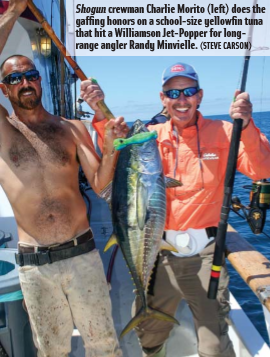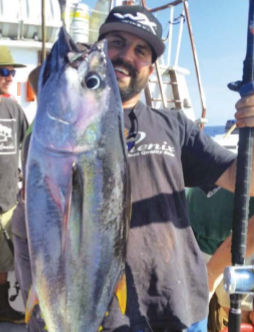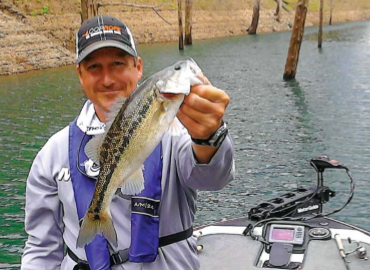Piranha Of The Surf
Small but Feisty, Barred Surf Perch provide great Fishing action on the California coast
By Tim E. Hovey
The end of February is transition time around the Hovey home. Hunting season is winding down, school breaks are over and a seasonal change is in the air.
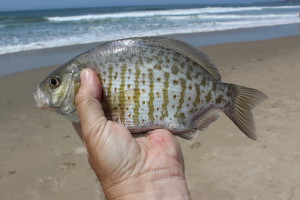
As the days get longer, I start dusting off the fishing rods and think about walking the beach and casting the shore. My grandfather taught me to fish when I was about 5, and from then on, whenever my family was around water, I wanted to know what was swimming below the surface. I gradually accumulated better gear and more experience and started fishing every chance I got.
As a boy, I’d spend summers down at the beach, fishing from the pier and the shore. When eating fish were caught, I’d string them up, load them up in my backpack and ride my bike home. With some help from my mom, we’d fillet up the catch and she’d cook them for
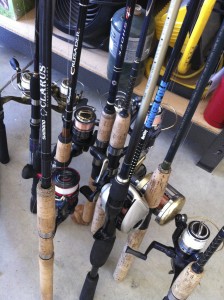
dinner. I can still remember feeling an immense amount of pride at being able to bring home food for my family with little more than a cheap rod and fresh bait I’d peel from the rocks down at the surf.
When I had kids of my own, I made sure I exposed them to the thrills and the bounty available to anyone willing to catch some bait and toss a line down at the beach. Probably one of my biggest thrills was watching my daughters’ faces as they caught their first fish in the surf and learned how to fish down by the shore.
Over the years, I’ve had the privilege of fishing in some amazing places. I’ve chased dorado in Baja, big game fish in the open ocean, monster kelp bass in the near shore kelp beds and freshwater species from trout to catfish. If it swims and can be caught, I’ve tried to catch it.
Of all the different types of fishing available to a Western angler, one of my favorite things to do is to walk the shores and cast into the waves for barred surf perch. I have been walking the Southern California beaches for over 40 years, and to me, nothing is more relaxing.
HIT THE SAND
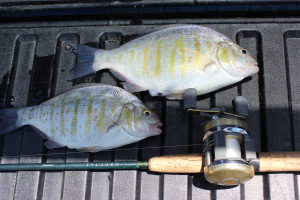
The beaches I fish are a few steps from where you can park and, except for the drive, a quick perch session is only a cast away. As long as the tide is moving, I’ll walk the beach and try my luck. During this time of year, fishing gear and a rod are always in the back of my truck.
Using a simple Carolina rig applied with sand crabs, plastic grubs or a Berkley bait, I’ll search the shore for what I call watery chaos. I like to fish in areas where the waves are disruptive and not uniform, places where the structure of the beach or submerged rocks agitate the water, churning up the sand. In these disturbed spots, the surf will kick up all sorts of food items, which attracts fish.
When I find these target areas, I’ll figure out what the surf is doing and cast into the moving water, so that the wave action washes my bait into the agitation zone. Bites can be quick and aggressive, so maintaining a tight line is important.
While this type of fishing lends itself to spinning gear, I love my baitcasters. Understanding what’s happening at the end of your line is the key to catching any fish, and I find I can do this more successfully with my bait-cast reel using a technique I learned long ago.
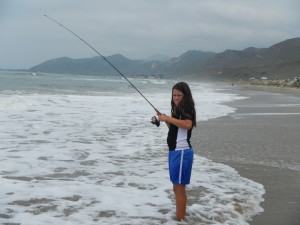
Holding the rod just above the reel with my left hand, I run the line under my thumb and over my index finger. This gives me a direct connection with anything occurring at the end of the line.
Some species of fish will inhale a lure or bait, and then quickly spit it out before the hook is set. Using this method, I’m actually able to feel subtle changes in the bait action, in my opinion, allowing me to catch more fish.
FROM SURF TO SKILLET
Barred surf perch are feisty fish, and large ones can weigh a couple of pounds. During a peak bite, the average fish are about a pound and can be a challenge on light tackle. They are abundant, and if you can find where they’re gathered, the action can be consistent.
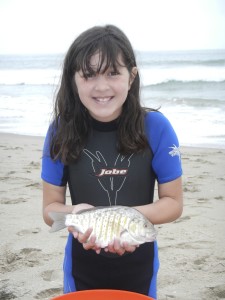
Surf perch are members of the Embioticidae family, which means they give birth to live young. During the spring and summer, it isn’t unusual to catch a very pregnant female – its swollen belly may hold as many as 20 little fish.
While I really enjoy catching my family’s dinner at the shore, I have a couple of self-imposed rules about what I bring home when targeting barred surf perch.
A majority of the time I release everything I catch when I fish down at the shore. However, I still love eating fish, and on occasion, I’ll save a few larger perch for the frying pan. These fish have a white, tender flesh that is perfect for frying or baking.
When I’m catching perch for dinner, I only take the males or larger females that have already birthed their young. If there’s any question about whether the fish is pregnant or not, it gets released.
I also take only what my family and I will eat that day (six will provide a meal for a family of four). I never freeze fillets or bring home more than I need. My favorite way to cook them is to dip the
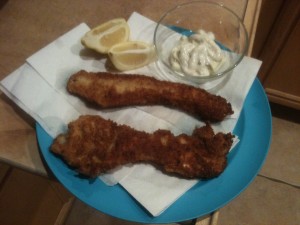
fillets in egg and then lightly roll them in flour. After a quick deep fry on both sides I serve them with fresh lemon slices and tarter sauce.
As I get older, I find that I fish for far different reasons now than when I was younger. For the first half of my life, fishing of any sort was my passion, bordering on an obsession. I’d plan trips all over and pursue any species that was worth catching.
Now, I fish for peace and quiet. When I sort through the tackle and grab a rod, I begin to relax. At the beach, any stress melts away in the pursuit of the feisty surf perch. When the season shifts to fishing, there’s no place I’d rather be than down at the shore, catching the piranha of the surf.

